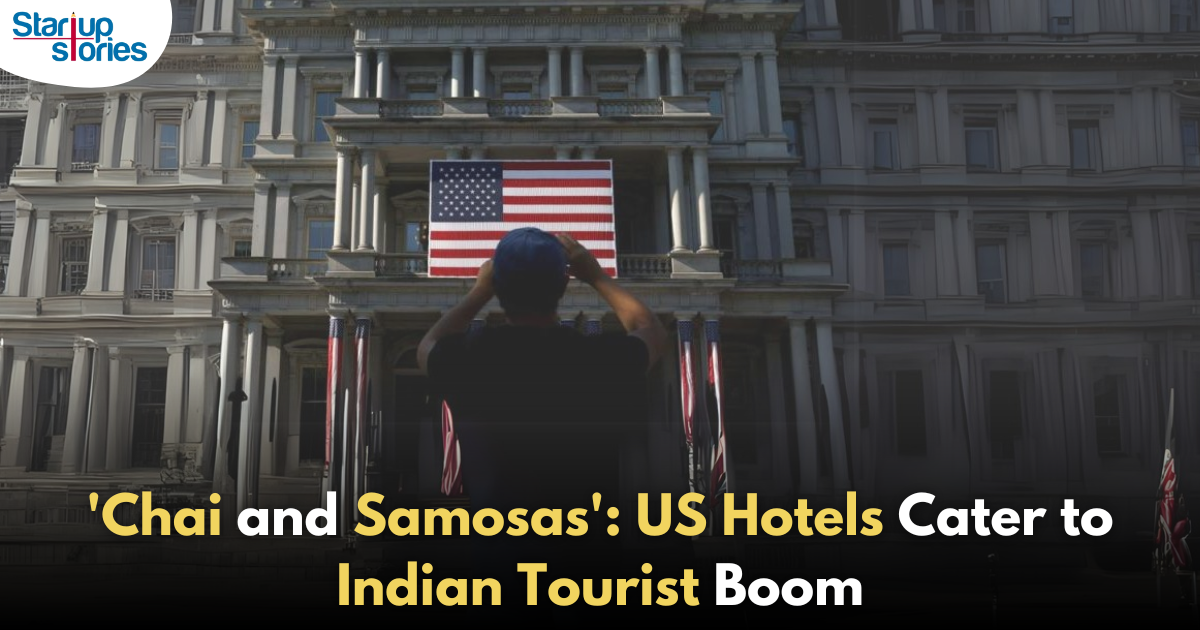Latest News
‘Chai and Samosas’: US Hotels Cater to Indian Tourist Surge to Revive Revenue!

The US tourism industry is experiencing a welcome boost thanks to a surge in Indian visitors. This increase comes at a time when domestic leisure spending is dipping and travel demand from East Asia remains sluggish, highlighting the significance of Indian tourists in revitalizing the sector.
Numbers Speak for Themselves
Nearly 1.9 million Indian tourists visited the US in the first ten months of 2024, marking a nearly 48% increase compared to 2019. This upswing is fueled by a 50% jump in visas issued for business travel and a 43.5% rise for leisure trips, according to the US National Trade and Tourism Office (NTTO). Notably, India has emerged as the second-largest source of foreign visitors to the United States, surpassing Germany and trailing only behind the UK.
Factors Driving the Boom
Several factors are contributing to this surge in Indian travel:
- Growing Middle Class: India’s burgeoning middle class is increasingly able to afford international travel, leading to higher travel budgets.
- Increased Flight Options: The availability of more direct flights between India and the US has made travel more accessible.
- Changing Travel Preferences: While wealthy travelers from East Asian countries have opted for shorter trips within Asia, Indian tourists are exploring long-haul destinations like the US.
In stark contrast, visitor volumes from East Asian countries such as China, Japan, and South Korea have significantly decreased compared to pre-pandemic levels, with declines of 44.5%, 50.8%, and 23.9%, respectively.
Filling the Void
While European tourists are gradually returning to the US, overall visitor numbers from major European countries like the UK, Germany, and France have not yet reached 2019 levels. This has left a gap in the US tourism industry that Indian travelers are now helping to fill.
Laura Lee Blake, CEO of the Asian American Hotel Owners Association, stated, “Indian travelers are playing a crucial role in reviving the industry. Their interest in exploring beyond major cities is spreading economic benefits across more destinations.” Budget and mid-scale hotels are particularly popular with Indian tourists, with some properties offering amenities that cater specifically to their preferences—such as chai and samosas in the lobby and Indian TV channels in guest rooms.
A Trend on the Rise
Travel booking platform Tripadvisor’s Viator brand reports a surge in US bookings by Indian travelers, jumping over 50% in 2024 and tripling compared to pre-pandemic levels. Airbnb’s Chief Business Officer, Dave Stephenson, confirmed this trend: “We’ve seen nights booked by Indians traveling to the US increase by over 45% in the past three years.”
The scheduled flight capacity between India and the US has also risen significantly—up 42.3% in 2024 compared to 2019—further facilitating this growth.
Looking Ahead
The outlook for the US tourism industry appears promising as it adapts to changing global travel dynamics. Grzegorz Kowalski, CEO of hotel booking platform Tripoffice.com, anticipates “growth in occupancy rates and revenue driven by a younger, experience-driven audience from India” in 2025. As hotels and travel companies continue to cater to Indian preferences and expand their offerings, they are well-positioned to capitalize on this influx of visitors.
Conclusion
The surge of Indian tourists is not only filling gaps left by declining visitor numbers from other regions but also revitalizing the US tourism industry as a whole. With increased flight capacities and tailored experiences for Indian travelers, this trend is likely to continue shaping the landscape of international tourism in the United States for years to come. As both countries strengthen their ties through increased travel opportunities, Indian visitors will play an increasingly vital role in supporting economic growth across various sectors within the US.
Latest News
Kuku FM’s $200 Million IPO: Mebigo Labs Hires Top Bankers to Lead Public Listing

Kuku FM’s parent company, Mebigo Labs, has hired leading investment banks to prepare for a 200 million dollar IPO in India, marking a major milestone for the country’s digital audio ecosystem. The Mumbai-based company has reportedly appointed Kotak Mahindra Capital, Axis Bank and Morgan Stanley’s India unit to manage the proposed share sale, which is likely to be launched on Indian stock exchanges once key regulatory steps are completed. This move signals strong intent to tap public markets and test investor appetite for subscription-led regional audio platforms in India.
The planned IPO proceeds are expected to help Kuku FM expand its content library, strengthen its regional language offerings and invest in technology to enhance user experience. With a focus on Hindi, Marathi, Tamil and other Indian languages, Kuku FM aims to capture the fast-growing audience in Tier 2 and Tier 3 cities seeking affordable audiobooks, courses and storytelling content. The funds could also provide additional firepower for marketing, partnerships and product innovation, helping the platform compete more aggressively in India’s crowded digital entertainment and creator economy landscape.
Founded in 2018, Kuku FM has built a subscription-driven business model and has reportedly scaled to millions of paying users, backed by multiple funding rounds from prominent investors. Its decision to pursue a 200 million dollar IPO positions it as one of the first major Indian audio platforms to attempt a public listing, potentially paving the way for other podcast and niche content startups to follow. As the IPO process moves forward, Kuku FM’s performance in the public markets will be closely watched as a key indicator of how investors value regional, knowledge-first audio platforms in India’s booming digital economy.
Latest News
Zerodha Reports 23% Profit Decline in FY25 as Revenues Miss Target

Zerodha experienced a challenging FY25, as its revenue fell 11.5% to ₹8,847 crore and net profit dropped 22.9% to ₹4,237 crore. This decline reflects tougher regulatory conditions, lower trading volumes, and increased operational costs in the brokerage market, all of which impacted core earning segments for the company.
Despite these headwinds, Zerodha improved its operating margin to 63.78% and built up significant cash reserves, reporting ₹22,679 crore in bank balances. Salary expenses and director remuneration increased, but disciplined cost controls helped the company maintain profitability and a debt-free balance sheet. The drop in active clients and increased compliance costs further contributed to the profit contraction.
Looking ahead, Zerodha’s resilience is supported by its robust cash position and operational efficiency. Maintaining steady margins, diversifying product offerings, and investing in technology positions the company to withstand future regulatory fluctuations and changing market sentiment reinforcing its status as one of India’s leading brokerage firms.
Latest News
Zoho Pay Debuts as India’s New UPI Challenger, Taking on PhonePe, Paytm, and Google Pay

Zoho Corporation has expanded its fintech portfolio with the launch of Zoho Pay, a UPI-based payments app built to challenge India’s top digital payment giants such as PhonePe, Paytm, and Google Pay. The new app supports peer-to-peer transfers, bill payments, QR-based transactions, and merchant settlements in a streamlined interface. Available as both a standalone app and an integrated feature inside Zoho’s privacy-driven messenger Arattai, Zoho Pay enables users to handle chats and payments in one platform, emphasizing data privacy and Made-in-India innovation.
Through seamless integration with Arattai, Zoho Pay allows users to send or request payments, split expenses, and conduct UPI-based transactions directly in their chat windows. Users can link bank accounts, scan dynamic QR codes, and receive audio confirmations of payments, ensuring speed and security. This design mirrors the simplicity of India’s leading UPI apps but is powered by Zoho’s non-advertising, privacy-first model. The integration aligns with Zoho’s mission to build a self-reliant digital ecosystem, where messaging and money management coexist securely.
In the competitive digital payments market, Zoho Pay differentiates itself through its tight business software integration with apps like Zoho Books, Zoho Payroll, and Zoho Commerce, offering small businesses unified access to payments, billing, and accounting. The company is also expanding its reach with POS devices for merchants featuring UPI QR, card payments, and instant reconciliation tools. With founder Sridhar Vembu’s vision of a ‘Chat + Pay’ ecosystem, Zoho Pay reflects a bold step toward redefining India’s fintech scene with a secure, ad-free, and locally developed alternative to global payment platforms.












droversointeru
April 8, 2025 at 1:43 pm
Does your site have a contact page? I’m having problems locating it but, I’d like to send you an email. I’ve got some recommendations for your blog you might be interested in hearing. Either way, great site and I look forward to seeing it improve over time.
casino en ligne francais
May 26, 2025 at 2:17 pm
If you are going for finest contents like I do, simply pay
a quick visit this website all the time because it presents
feature contents, thanks
binance referral
September 9, 2025 at 8:39 pm
Can you be more specific about the content of your article? After reading it, I still have some doubts. Hope you can help me.
binance
September 29, 2025 at 11:28 am
Your point of view caught my eye and was very interesting. Thanks. I have a question for you.
MM88
November 7, 2025 at 10:00 pm
Với giao diện mượt mà và ưu đãi hấp dẫn, MM88 là lựa chọn lý tưởng cho các tín đồ giải trí trực tuyến.
GO88
November 8, 2025 at 2:57 pm
Tham gia cộng đồng game thủ tại Go88 để trải nghiệm các trò chơi bài, poker phổ biến nhất hiện nay.
谷歌蜘蛛池
November 8, 2025 at 9:03 pm
利用强大的谷歌蜘蛛池技术,大幅提升网站收录效率与页面抓取频率。谷歌蜘蛛池
站群程序
November 13, 2025 at 8:52 pm
搭载智能站群程序,自动化搭建与管理,为SEO项目提供核心驱动力。站群程序
MM88
November 13, 2025 at 9:48 pm
Khám phá thế giới giải trí trực tuyến đỉnh cao tại MM88, nơi mang đến những trải nghiệm cá cược thể thao và casino sống động.
J88
November 18, 2025 at 10:38 pm
Đến với J88, bạn sẽ được trải nghiệm dịch vụ cá cược chuyên nghiệp cùng hàng ngàn sự kiện khuyến mãi độc quyền.
Kuwin
November 19, 2025 at 7:40 am
kuwin sở hữu kho game đa dạng từ slot đến trò chơi bài đổi thưởng, mang đến cho bạn những giây phút giải trí tuyệt vời.
iwin
November 21, 2025 at 6:49 pm
iwin – nền tảng game bài đổi thưởng uy tín, nơi bạn có thể thử vận may và tận hưởng nhiều tựa game hấp